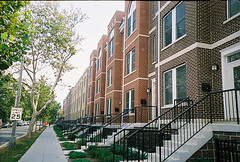Wall Street Journal: urban living, smart growth are in demand

Posted June 18, 2008 at 1:09PM
 If it’s in the business newspaper of record, you know it’s mainstream. And, while you read it in this blog four months ago, citing the same experts, it’s nice to know that the WSJ is getting the message:
If it’s in the business newspaper of record, you know it’s mainstream. And, while you read it in this blog four months ago, citing the same experts, it’s nice to know that the WSJ is getting the message:
Just as low interest rates and aggressive mortgage financing accelerated expansion of the suburban fringe to the point of oversupply, "the spike in gasoline prices, layered with demographic changes, may accelerate the trend toward closer-in living," said Arthur C. Nelson, director of Virginia Tech's Metropolitan Institute in Alexandria, Va.
"All these things are piling up, and there are fundamental changes occurring in demand for housing in most parts of the country."Christopher Leinberger, a visiting fellow at the Brookings Institution and a developer of walkable areas that combine housing and commercial space, describes the structural shift as the "beginning of the end of sprawl."
Recipe for Reurbanization
Todd Zimmerman, a housing consultant and an early advocate of pedestrian-friendly community planning known as New Urbanism, said demographic and cultural factors explain a big part of the trend. . . . He said the populations of Americans in their 20s and in their 50s are rising and will add eight million potential housing consumers by the time their numbers peak in 2015. "You've got a recipe for reurbanization on a dramatic scale," he said . . .
While high gas prices are a boon to New Urbanism and other "smart-growth" planning concepts, in practice such mixed-use projects often are harder to execute -- from acquiring local approval to securing Wall Street financing -- than the traditional suburban tract-housing model. The challenges for cities are considerable, from investing in public-transportation systems to creating incentives for developers to accommodate the new urban housing demand.
Creating those incentives is exactly what some of us are trying to do in LEED for Neighborhood Development. Unfortunately, we’re in a bit of a struggle right now with some of our private-sector partners who seem to want the system to honor leapfrog sprawl, too, if it is “green” [sic]. They haven’t gotten the memo yet. Wish us luck. By the way, CNN ran a similar story on Monday. To invoke one of those pretentious phrases, we are seeing a paradigm shift in American living patterns, and it’s coming just in time. You read it here first.